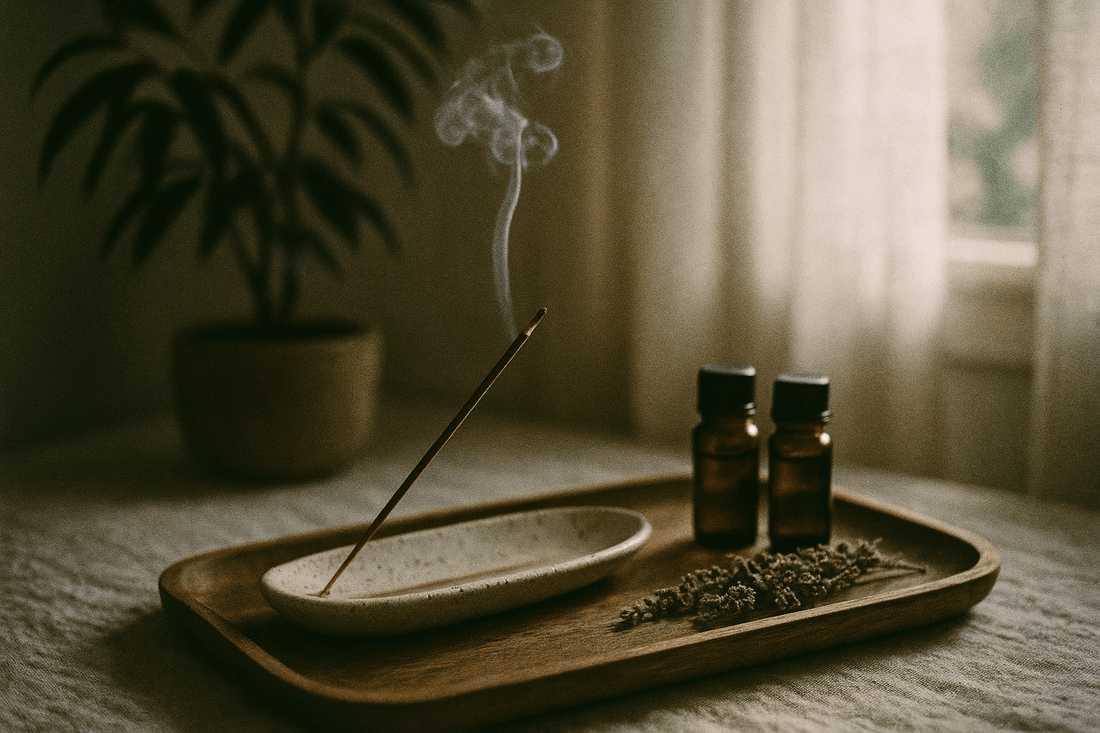
Exploring Incense and Aromatherapy
Scent is memory. It’s emotion, energy, and atmosphere—carried through air and anchored in breath. For thousands of years, humans have used incense and aromatherapy to mark sacred moments, shift energy, and reconnect with the self. Today, these ancient tools are finding their way back into modern life, not just as rituals of beauty, but as practices of wellness.
Whether you’re lighting incense to begin your day or diffusing essential oils to soften your evening, you’re engaging in a tradition as old as human civilisation. In this guide, we’ll explore the origins of incense and aromatherapy, their benefits, and how to bring their power into your everyday life.

A History Rooted in Ritual
The practice of using scent for healing and spiritual purposes is ancient—and widespread. Evidence of burned herbs, resins, and fragrant woods dates back over 6,000 years, across cultures from Egypt and India to China, Mesopotamia, and Greece.
Incense
The word incense comes from the Latin incendere, meaning “to burn.” Early civilisations burned frankincense, myrrh, agarwood, sandalwood, and cinnamon during religious ceremonies and healing rituals. In ancient Egypt, incense smoke was believed to carry prayers to the gods. In India, it became central to Ayurvedic healing and temple offerings. In East Asia, incense played a key role in Buddhist meditation, Confucian rites, and the Japanese art of Kōdō—the Way of Incense.
Aromatherapy
While incense is rooted in burning solid materials, aromatherapy is the use of plant-based essential oils for emotional, spiritual, and physical healing. The ancient Greeks used infused oils in baths and massages, while traditional Chinese medicine and Indian Ayurveda recognised the power of scent to balance body and mind. The term "aromatherapy" was formally coined in the 20th century, but its roots are far older.
Both practices are united by a shared understanding: scent affects the body, mind, and spirit.
The Benefits of Incense and Aromatherapy
Incense and aromatherapy don’t just make a room smell nice—they help us feel better, think more clearly, and reconnect with ourselves. Here’s how they work:
1. Supports Emotional Balance
A recent study has shown that certain scents can calm the nervous system, reduce stress, and improve one's mood. Lavender, sandalwood, and palo santo are known for their soothing properties, while citrus and mint can uplift and energise.
2. Enhances Mindfulness and Focus
Scent acts as an anchor to the present moment. Burning incense during meditation or yoga can deepen your focus, slow your breathing, and support a clear, open mind.
3. Improves Sleep and Restfulness
Scents like rose, chamomile, or cedarwood can support better sleep by helping the body wind down naturally. Lighting an incense cone before bed can become a cue to rest.
4. Cleanses and Refreshes Your Space
Burning incense, especially resins like frankincense or blends, can help clear stagnant energy and freshen the atmosphere, both physically and energetically.
5. Connects to Memory and Emotion
The limbic system, which processes scent, is tied to emotion and memory. Some evidence suggests scents can trigger deep feelings, memories, or simply a sense of comfort and safety.
A Modern Practice Rooted in Ancient Wisdom
Bringing incense and aromatherapy into your daily life doesn’t require complexity—just intention.
Start with small rituals. Light an incense stick during your morning tea, or add a few drops of essential oil to a diffuser while working. Use different scents to mark transitions—beginning a creative session, closing your day, or preparing for rest.
Here are a few simple ideas:
- Morning Clarity: Burn Morning Ember incense for focus and energy
- Work Reset: Diffuse peppermint or lemongrass during afternoon slumps
- Evening Wind-down: Use Moon Bloom incense or lavender oil before bed
- Space Clearing: Burn palo santo, myrrh, or a citrus blend to refresh your room
Let your practice be guided by how you want to feel—not by rules. That’s the beauty of scent: it’s deeply personal, and always evolving.
Tips for a Mindful Scent Practice
To get the most out of incense or aromatherapy, consider these gentle tips:
- Choose natural products. Avoid synthetic fragrances, which may cause irritation or lack the layered nuance of real botanicals.
- Ventilate your space. Especially with incense, ensure airflow so smoke doesn’t build up.
- Start small. One stick, one drop, one breath. Scent works subtly—more isn’t always better.
- Be present. Don’t just light and forget. Let the act of lighting be a signal to return to yourself.
- Trust your senses. If a scent feels right, it probably is. Your body knows what it needs.
Final Thoughts: Scent as Sanctuary
In a world that moves fast, incense and aromatherapy offer something beautifully simple: a moment to breathe.
They don’t require WiFi, credentials, or screens—just your senses and your presence. Whether you’re using scent to support your wellbeing, deepen your spiritual practice, or simply create beauty in your space, you’re joining a lineage of people across time who’ve turned to the power of aroma for healing, clarity, and connection.
So the next time you light an incense stick or open a bottle of essential oil, remember: this is more than a scent. It’s a quiet act of remembering who you are.
